|
||||||||||||||||||||||
|
In the aftermath of World War 2, production of cars was slow to re-start because the view of most governments of the day was that automobile production diverted resources from more essential needs. When the green light was eventually given, most manufacturers were obliged to export the majority of their products since this was a way of earning foreign currency. Coupled with this was a policy of restricting imports wherever possible ? usually by the imposition of swingeing import taxes. All this meant that new cars were few and far between on the roads of Europe and furthermore, foreign products were rendered uncompetitive. In the immediate post war years, the French bought French cars almost exclusively, the British bought British, the Germans bought German and the Italians bought Italian. In the case of the United Kingdom, a number of foreign manufacturers had implant factories in Britain – Ford, Vauxhall (part of GM) and surprisingly, Citroën too all built cars in Britain. For the full story on Citroën’s UK operations, buy a copy of John Reynolds’ excellent book From A to X. In other countries without an indigenous motor industry, foreign manufacturers set up factories. Citroën had a factory in Belgium and in Great Britain. As motor production geared up, markets remained essentially patriotic and it was not really until the mid to late seventies that internationalisation became more prevalent. Of course some vehicles always managed to transcend national boundaries and achieve popularity abroad ? the 2CV, VW Beetle and Mini spring to mind. Nationalism led to cars being designed with national characteristics in mind. In France for instance, the fiscal régime mitigated against large capacity engines and the poor state of the roads led to softly sprung cars being the norm. In the United Kingdom, congested, narrow but comparatively well surfaced roads led to firmer sprung cars with comparatively large capacity engines. Little importance was placed on good handling and technical innovation on the whole, played second fiddle to styling. In France, technical innovation took precedence over annual restyling as a result of which, technophiles found the products of this country very appealing. Furthermore, product runs measured in decades rather than years resulted in on-going improvements and refinements that were denied to the purchasers of other countries? short-termist manufacturers. By the time the EEC was formed and fiscal barriers started falling, the Japanese manufacturers had started their onslaught and in response, European manufacturers had to both internationalise their products and enter into partnership with companies that had hitherto been rivals. In doing so, what had made them unique was dissipated and diluted to the extent that the product of one European manufacturer is all but identical to the product of another. This trend continued throughout the eighties and even into the first half of the nineties but as the millennium approaches, there are signs that this trend will be reversed. Many are the names that have fallen by the wayside in the last 50 years and almost as numerous are the names that still exist but which are now owned by erstwhile competitors. Citroën was not immune to these trends ? in fact the company was more vulnerable than most and what was so surprising was that it remained independent (albeit under the wings of Michelin) for so long and that while it lurched from imminent financial catastrophe to inevitable financial catastrophe, the company produced some of the most innovative and idiosyncratic cars ever built. The following pages do not purport to do more than offer a pictorial comparison of Citroëns versus some of their competitors together with the briefest of analyses of the way that Citroëns stacked up against their peers during the post war years up to the early seventies. |
||
 |
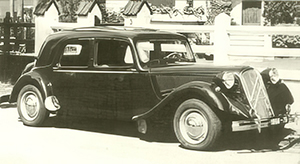 |
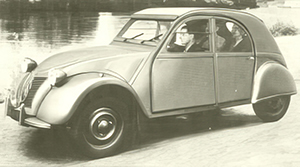 |
|
Citroën's Traction Avant 11 CV was the mainstay of the range from the time production recommenced after the war until 1957. The DS19 launched in 1955 replaced the ageing Traction Avant in Citroën's range. |
Citroën's Traction Avant 15 CV was the haut de gamme model until the launch of the DS 19 in 1955. The ID19 was a simplified DS and replaced the Traction Avant 11 CV. |
Citroën's 2 CV
went on sale in 1949 and production continued until 1990. The Ami 6, launched in 1961 was an attempt to compete in the mid range market. |
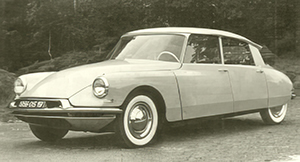 |
 |
 |
 |
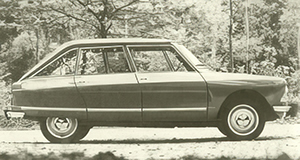 |
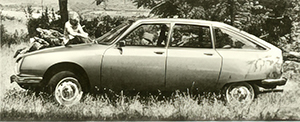 |
|
Like the Ami 6, the Dyane, launched in 1968, was based on the 2 CV. The SM, also launched in 1970 was Citroën's new haut de gamme model and a flagship for the French automotive industry. |
The Ami 8 replaced the Ami 6 but retained the 2 CV's mechanical bits. |
Citroën's first foray into the highly competitive mid-market sector was the techologically dense GS, launched in 1970. By the time the successor to the DS, the CX was launched in 1974, the company was in the hands of Peugeot. |
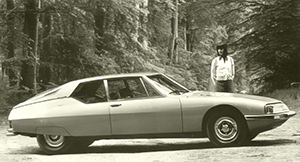 |
Peugeot may not
have had the radical vision of Citroën but the company brought some
much needed common sense to the company. |
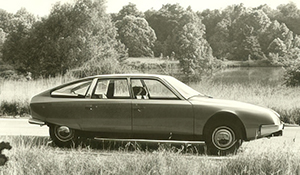 |

